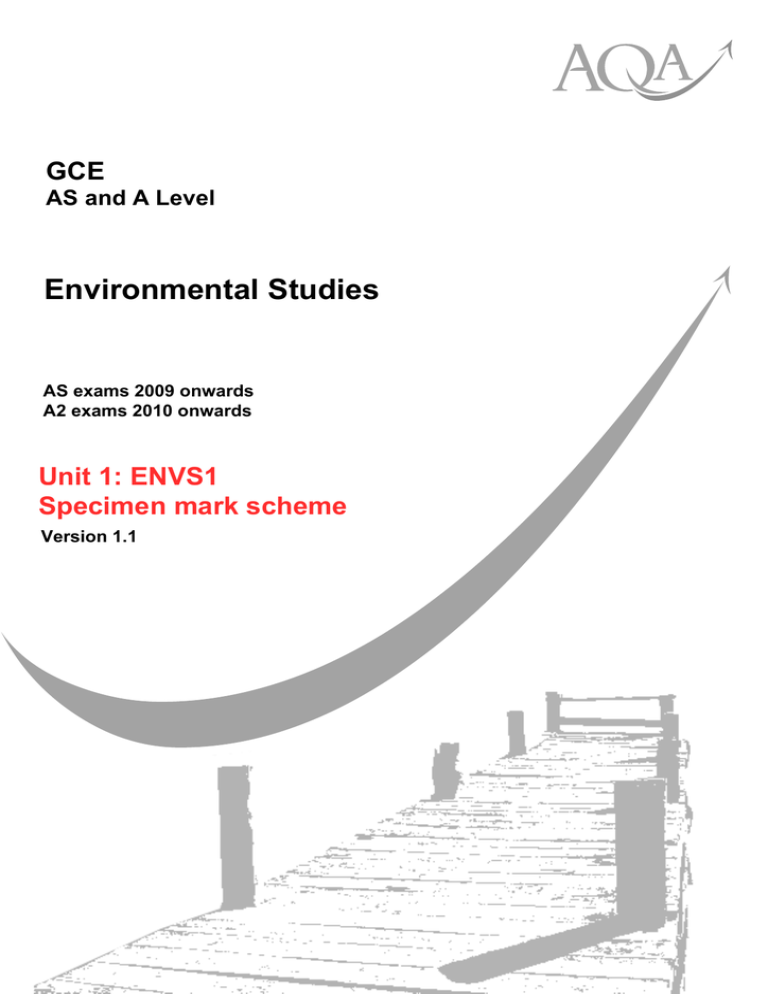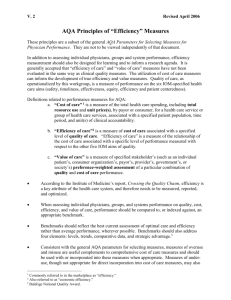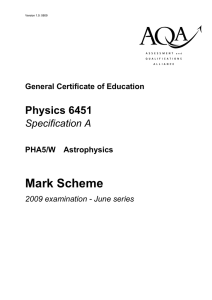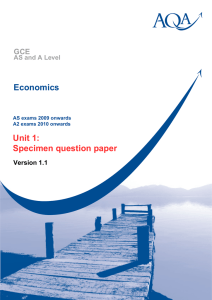
GCE
AS and A Level
Environmental Studies
AS exams 2009 onwards
A2 exams 2010 onwards
Unit 1: ENVS1
Specimen mark scheme
Version 1.1
abc
General Certificate of Education
Environmental Studies
The Living Environment
ENVS1
Specimen Mark Scheme
for 2009 examination
The specimen assessment materials are provided to give centres a reasonable idea of the general
shape and character of the planned question papers and mark schemes in advance of the first
operational exams.
For operational papers, mark schemes are prepared by the Principal Examiner and considered,
together with the relevant questions, by a panel of subject teachers. The mark scheme includes any
amendments made at the standardisation meeting attended by all examiners and is the scheme
which was used by them in this examination. The standardisation meeting ensures that the mark
scheme covers the candidatesí responses to questions and that every examiner understands and
applies it in the same correct way. As preparation for the standardisation meeting each examiner
analyses a number of candidatesí scripts: alternative answers not already covered by the mark
scheme are discussed at the meeting and legislated for. If, after this meeting, examiners encounter
unusual answers which have not been discussed at the meeting they are required to refer these to
the Principal Examiner.
It must be stressed that a mark scheme is a working document, in many cases further developed
and expanded on the basis of candidatesí reactions to a particular paper. Assumptions about future
mark schemes on the basis on one yearís document should be avoided; whilst the guiding principles
of assessment remain constant, details will change, depending on the content of a particular
examination paper.
Further copies of this Mark Scheme are available to download from the AQA Website: www.aqa.org.uk
Copyright © 2007 AQA and its licensors. All rights reserved.
COPYRIGHT
AQA retains the copyright on all its publications. However, registered centres for AQA are permitted to copy material from
this booklet for their own internal use, with the following important exception: AQA cannot give permission to centres to
photocopy any material that is acknowledged to a third party even for internal use within the centre.
Set and published by the Assessment and Qualifications Alliance.
The Assessment and Qualifications Alliance (AQA) is a company limited by guarantee registered in England and Wales (company number 3644723) and a registered charity (registered charity number 1073334).
Registered address: AQA, Devas Street, Manchester M15 6EX
Dr Michael Cresswell Director General
Environmental Science - AQA GCE Specimen Mark Scheme 2009 series
Environmental Studies
Specimen Unit
Mark Scheme
ENVS1
Instructions: ; = 1 mark / = alternative response A = accept R = reject
Question 1
1
(a)
Importance to living organisms
Chemical reactions take place in solution/needed for nutrient uptake/
transport of substances/dilution of waste
Floating ice insulates/prevents water freezing solid (for survival of organisms
beneath)/albedo controls climate
[A reference to ice layer creating habitat]
Allows light to penetrate for water plants/photosynthesis
[A allows predators to see prey in water (or converse)]
;
;
;
3
1
(b)
Allows efficient enzyme activity/speed of chemical reaction;
high temperatures denature/deactivate enzymes;
[R ëkillí enzymes]
temperature range allows water in liquid state;
MAX 2
Total marks = 5
_____________________________________________________________________________
Mark Scheme ENVS1
Environmental Science - AQA GCE Specimen Mark Scheme 2009 series
Question 2
2
(a)
A community of species interacting with physical environment;
2
(b)
Direct exploitation
overfishing;
effects (of overfishing) on other named species;
collection of coral/sponge/shells/other named species;
dredging;
MAX 3
Direct damage
boat/anchor damage;
swimmers /divers/snorkellers;
litter;
pollution by tourists/boats;
introduced species;
1
MAX 3
Indirect damage (by activities on land)
(toxic) pesticides;
sewage/fertiliser increasing algal cover;
global warming causing sea level/temperature change/coral bleaching;
development causing increased turbidity/sediment; MAX 3
2
(c)
Storm protection (reduced costs of);
tourism (income);
habitat/breeding ground for commercial fish;
specific egs;;
5
MAX 4
Total marks = 10
___________________________________________________________________________
Mark Scheme ENVS1
Environmental Science - AQA GCE Specimen Mark Scheme 2009 series
Question 3
3
(a)
Species in danger of extinction on current trends (throughout most or all of its
range);
3
(b)
Two comments on data with justification;;
as proportion of total population in reserves has increased ñ increased importance;
as population outside has grown ñ reduced importance;
MAX 2
3
(c)
Loss of pollinators;
reduced seed dispersal;
reduced nutrient cycling;
eg of each;;;
3
(d)
1
MAX 3
Activities;;
egs of affected species;;
eg
roadkill
of badgers/deer/hedgehogs/otters
fishing bycatch
of dolphins/sharks/turtles
farm harvesting
of nesting birds/harvest mice
introduced species
on named competitor/named predated species
pollution
on named affected species
drainage
on named wetland species
MAX 4
Total marks = 10
___________________________________________________________________________
Mark Scheme ENVS1
Environmental Science - AQA GCE Specimen Mark Scheme 2009 series
Question 4
4
(a)
Difficulties keeping species in captivity
space needed;
feeding problems;
species inter-relationships;
required abiotic conditions
Breeding problems
breeding triggers not provided;
small gene pool/inbreeding;
hybridisation between sub-species;
lack of parenting skills;
Release problems
inability to find food;
inability to avoid toxic food;
inability to avoid predators;
not socially accepted;
original threat still exists;
lack of suitable habitat;
4
(b)
MAX 2
MAX 2
MAX 2
4
Quality of Written Communication is assessed in this answer.
Named species;;
control of succession;
culling/removal of undesirable species;
provision of suitable conditions;
biological corridors;
MAX 4
Quality of Written Communication
Mark
2
1
0
Descriptor
All material is logically presented in clear, scientific English and continuous
prose. Technical terminology has been used effectively and accurately
throughout. At least half a page of material is presented.
Account is logical and generally presented in clear, scientific English.
Technical terminology has been used effectively and is usually accurate.
Some minor errors. At least half a page of material is presented.
The account is generally poorly constructed and often fails to use an
appropriate scientific style to express ideas.
MAX 2
Total marks = 10
___________________________________________________________________________
Mark Scheme ENVS1
Environmental Science - AQA GCE Specimen Mark Scheme 2009 series
Question 5
5
(a)
(i)
Named conflict/ref. to planning;
advocate/opponents put their cases;
in a public setting/open to public;
inspector decides/reports to Secretary of State;
5
(a)
(ii)
5
(a)
(iii) Surround urban areas;
restricts development/protect farmland/countryside;
prevent towns merging;
prevent historic towns being lost;
stop urban sprawl;
encourage development of brownfield sites;
MAX 2
Biological corridor;
new habitat creation;
expansion of existing habitat;
no through road;
specific description of how change benefits wildlife;;
eg biological corridor
- links areas of same habitat to increase breeding population
MAX 4
5
(b)
Monetary value of all aspects considered;
if B>C (may go ahead)/converse/ref. to net figure;
MAX 2
2
Total marks = 10
___________________________________________________________________________
Mark Scheme ENVS1
Environmental Science - AQA GCE Specimen Mark Scheme 2009 series
Question 6
6
(a)
Presence of rare/endangered species;
good example of community requiring protection;
6
(b)
Maximum number of visitors that can be accepted without
damaging dunes;
6
(c)
(i)
Primary succession is the series of community changes which occur on an
entirely new habitat which has never been colonized before;
secondary succession is the series of community changes which take
place on a previously colonized, but disturbed or damaged habitat;
2
6
(c)
(ii)
Trampling creates bare ground;
1
6
(d)
(i)
Named environmental gradient;
named situation/location;
2
6
(d)
(ii)
D = 41 40 / (31 30) + (6 5) + (3 2);
= 1.6977;
[A 1.69/1.70]
6
(d)
(iii) Increase;
6
(d)
(iv) Habitat stability;
population size re breeding viability;
ref to interspecies relationship;
2
Definition of time zoning;
eg of time zoning;
how it helps wildlife conservation;
3
6
(e)
MAX 1
1
2
MAX 1
Total marks = 15
___________________________________________________________________________
Mark Scheme ENVS1
Environmental Science - AQA GCE Specimen Mark Scheme 2009 series
ENVS1
Assessment grids
Question number
Specification Section
1
3.3.1
2
3
4
5
5
6
7
3.3.3
4
3
8
3.3.4
3.3.5
10
1
2
5
AO2
Application, analysis and
evaluation
Mark Scheme ENVS1
10
7
14
8
+2QWC
10
4
4
10
15
58+2
= 60
3
4
5
6
Total
8
4
6
3
26
4
2
7
23
2
5
9
10
15
58+2
= 60
10
AO3
Experiment and
investigation
Total
25
Question number
Specification Section
AO1
Knowledge with
understanding
4
10
5
Total
5
3.3.2
Total
6
2
5
10
10
8
+2QWC






